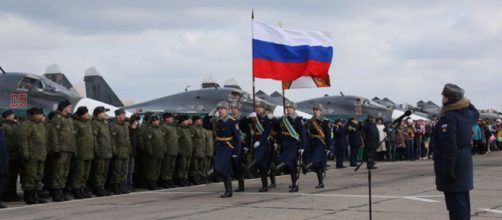After the decisive victory in the Deir-es-Zor province, Putin told the Russian fighter pilots, they could "return home victorious". We can consider it to be close to the truth, but in the meantime... something like 'terror-related explosion' in New York happened.
Question number one: how successful was the shelling?
Since Moscow launched a campaign of air strikes against all enemies of President Bashar al-Assad in September 2015, the Khmeimim airbase was the core of Russia's war effort in Syria. According to the Ministry of Defence in Moscow, two Russian servicemen were killed when the base was attacked for the first time on 31 December.
Only a few days later, the Russian military correspondent for the (privately owned) Kommersant newspaper, Roman Saponkov published photos on social media that appeared to show warplanes damaged in the mortar attack. By the way, the Kommersant was the first publication which delivered a report about that shelling. Speaking to the BBC, Mr Saponkov reiterated that the photos came from a reliable anonymous source.
Despite of this the official Russian language press, not to mention the state-controlled television, made no note of the planes damaged in the airfield movement area. There was, however, much talking about how the Russian citizens and charitable organisations are supporting the Syrian people with humanitarian aid.
Also about its deliverance from Khmeimim air base.
Question number two: why were the rebels able to get close enough to the perimeter to fire mortar rounds?
The region has been relatively peaceful since the beginning of the war in 2011. Although the radicalised Sunni Arabs have had a consistent presence in the northeastern mountains, two years ago Hezbollah and government forces, backed by the Russian air force and artillery, captured the town of Salma, the last rebel bastion in Latakia Governorate. The Governorate is the stronghold of the Alawites and Christians, who are the main pillar of the informal al-Assad dynasty. It was the main reason for the absence of hardened aircraft shelters in Khmeimim.
Very important question number three: who is behind the foiled drone attack on Russian military bases in Khmeimim and Tartus?
According to the official Russian explanation, presented by Russian President Vladimir Putin himself: "As for these attacks, we have every reason to believe that they were carefully planned, and we know when and where the drones were delivered, and how many. These aerial vehicles were camouflaged as improvised devices. Let me emphasise, that this is only camouflage. In fact, they clearly include high-technology components."(Meeting with heads of Russian print media and news agencies, en.kremlin.ru)
What if a great power is again supporting the international terrorism?
Doing it without a thought as to the pain and misery of the victims, and an immense danger such policy could mean even for the population of United States?
In all justice, we have to remember that many times the so-called national liberation movements, who carried out indiscriminate attacks, killing both military personnel and unarmed civilians, were supported by great powers, including the Soviet Union and China. The Syrian civil war is no doubt at the same time the first Proxy war of the 21st century.
To stop the brutal murders, but it's not the sole purpose
The Russian soldiers believe they have to fight against the murderers of innocent people, terrorists, the main sectarian hordes. They said from the very beginning: we must fight for our country, our families, women and children, so that in the end we can all go home and live in peace.
On the other hand, Putin's goals in Syria went beyond saving the Christians, Sufis or Alawites.
First, the only previous time Russia had to deploy troops overseas was to Cuba in 1962, so it was important to prove if they have this capability now. Second, it's a battle-testing of the recently reformed and rearmed Russian Navy, fleet air arm, fighter jets squadrons etc. The Russian armed forces managed to test more than 200 newest types of weapons.
There is no guarantee that the opposite side wouldn't undergo the temptation to do more or less the same. Most probably playing the armed opposition card, and therefore the unarmed civilians must suffer a terrible fate till the most probably distant end of hostilities.


